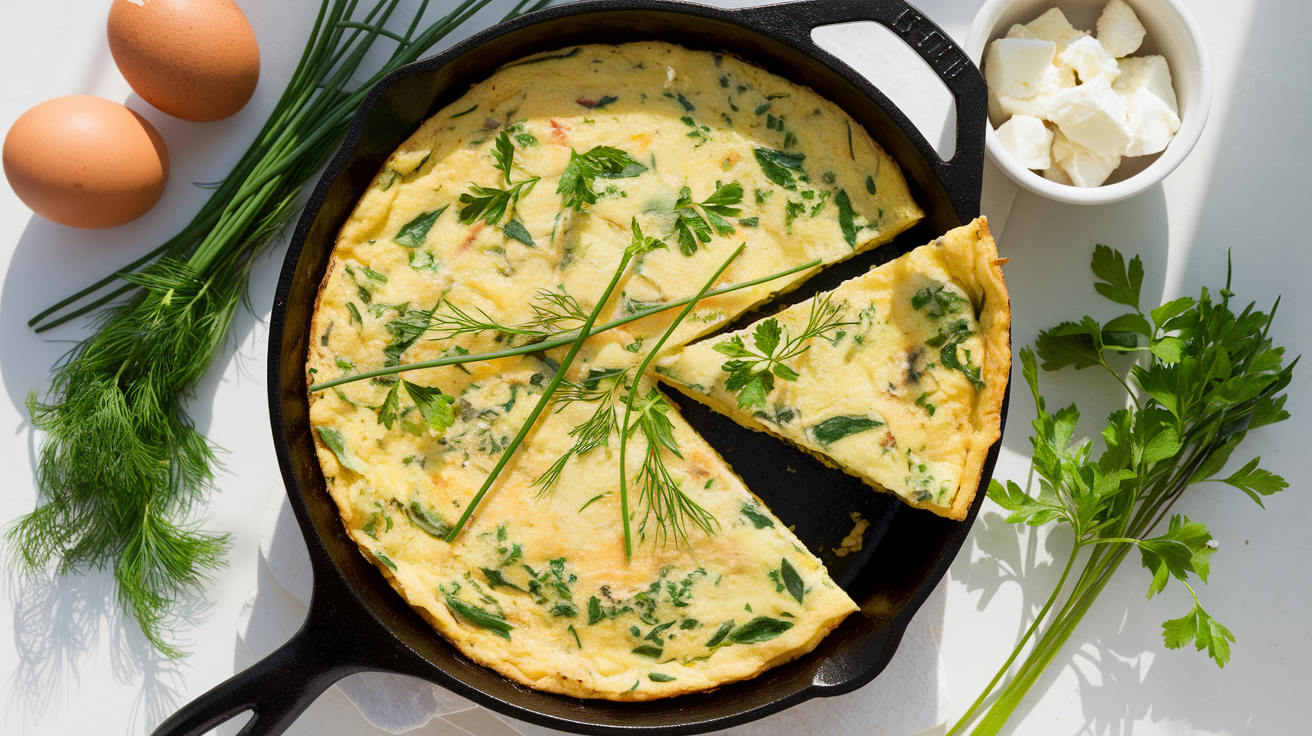The golden morning light illuminated my kitchen counter, showcasing vibrant farmers market herbs I’d just unpacked—slender chives, feathery dill, bright parsley, and most captivating, tarragon with its distinctive anise scent. These herbs became the foundation of my now-signature Spring Herb Egg Frittata.
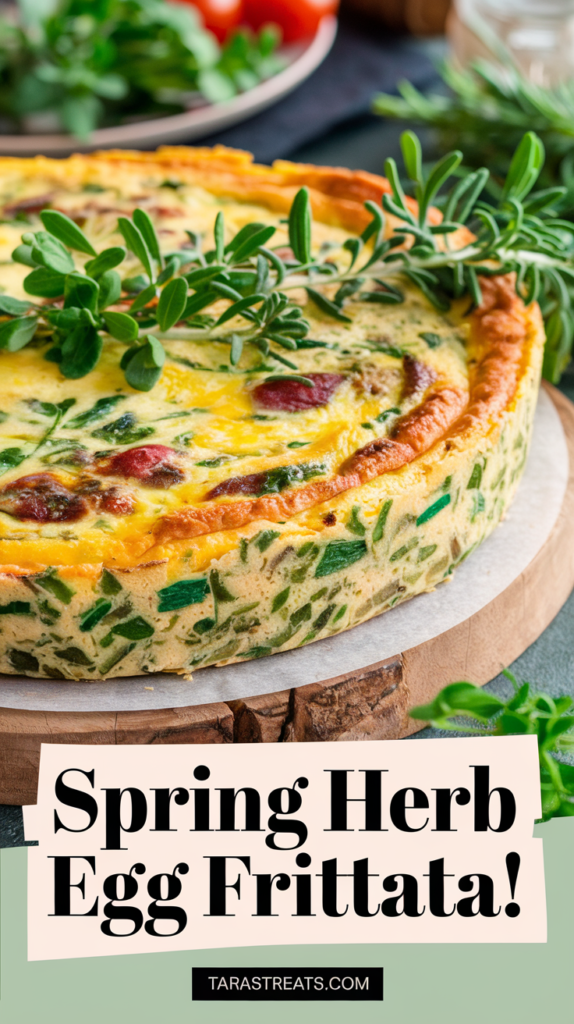
This recipe emerged during a Sunday panic when my in-laws announced an impromptu visit, giving me just forty minutes to transform from pajama zombie to polished hostess with brunch ready. A desperate refrigerator search revealed eggs, forgotten goat cheese, and yesterday’s herbs. The resulting frittata didn’t just save the day—it crowned me the family’s brunch queen.
What makes this frittata special is how it captures the season’s essence. Eggs provide a silky canvas for fresh herbs, reminiscent of my cooking studies in southern Italy. My host mother Giulia always insisted that “La semplicità è l’ultima sofisticazione”—simplicity is the ultimate sophistication. This frittata embodies that philosophy, elevating humble ingredients into something worth gathering around, whether for casual family brunch or elegant dinner with friends.
Why You’ll Love This Dish
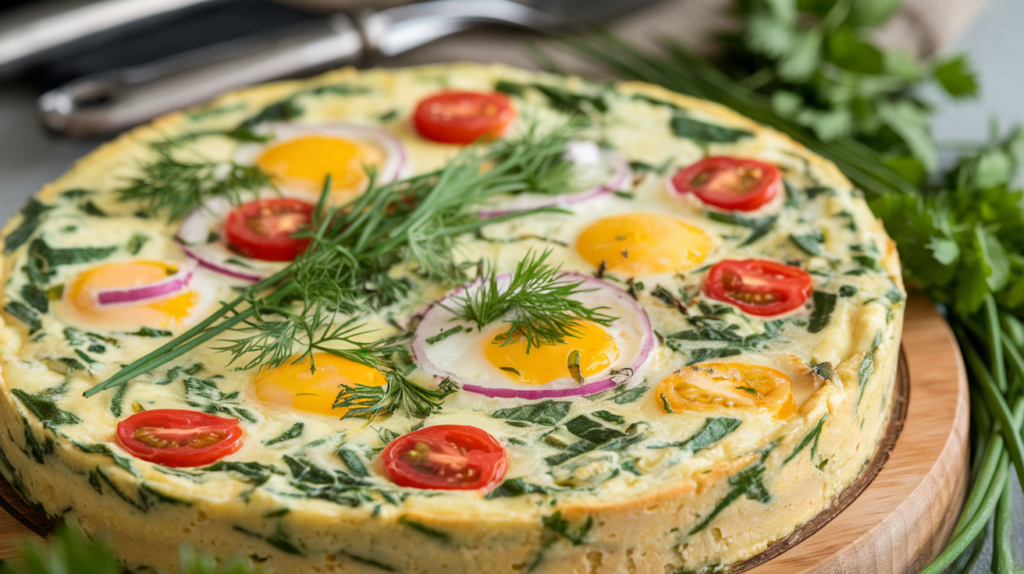
A Canvas for Seasonal Creativity
This Spring Frittata recipe is infinitely adaptable to whatever looks best at your market. Asparagus looking particularly tempting? Toss it in! Found some beautiful spring peas? They’ll be perfect! The egg base provides a neutral backdrop that lets seasonal ingredients shine while herbs add aromatic complexity that elevates everything.
Make-Ahead Marvel
What could be better than a dish that tastes even more amazing the next day? This egg frittata can be made ahead and served at room temperature, making it perfect for entertaining. I often make it the night before a gathering, which frees me to enjoy my guests rather than being tethered to the stove.
One-Pan Wonder
As someone with a pathological dislike of washing dishes, I’m always looking for recipes with minimal cleanup. This Spring Herb Egg Frittata requires just one oven-safe skillet from start to finish. The stovetop-to-oven method ensures a perfectly cooked frittata with a golden top and no extra pans to scrub.
Nutritional Powerhouse
This isn’t just a pretty dish – it’s packed with protein from the eggs, calcium from the cheese, and a rainbow of nutrients from the herbs and vegetables. As someone who believes food should be both delicious and nourishing, I love that this spring frittata checks both boxes effortlessly, making it an excellent choice for balanced Spring Meals Dinners.
Budget-Friendly Elegance
Some of the most impressive dishes come with intimidating grocery bills, but not this one. Eggs remain one of the most affordable protein sources available, and a small amount of fresh herbs goes a remarkably long way. This dish proves that elegant Spring Dishes don’t have to break the bank.
Versatile Mealtime Solution
Is it breakfast? Lunch? Dinner? Yes, yes, and absolutely yes! This frittata transcends traditional mealtime boundaries. Pair it with a simple green salad for Easy Spring Dinner Recipes, serve it alongside crusty bread for brunch, or cut it into small squares for an elegant appetizer. Few dishes can move between occasions with such grace.
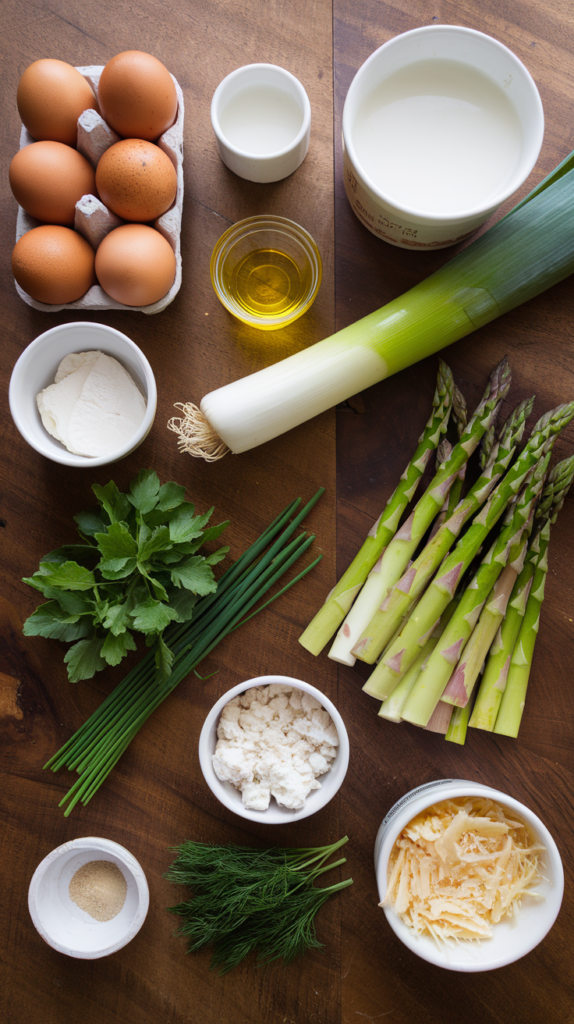
Ingredients for the Spring Herb Egg Frittata Recipe
- 10 large eggs, preferably organic and free-range
- 1/3 cup whole milk or half-and-half
- 2 tablespoons olive oil
- 1 medium leek, white and light green parts only, thoroughly cleaned and thinly sliced
- 1 cup asparagus, woody ends removed, cut into 1-inch pieces
- 2 tablespoons fresh chives, finely chopped
- 2 tablespoons fresh flat-leaf parsley, chopped
- 1 tablespoon fresh tarragon, chopped
- 1 tablespoon fresh dill, chopped
- 4 ounces goat cheese, crumbled
- 1/2 cup freshly grated Parmigiano-Reggiano
- 1/2 teaspoon kosher salt
- 1/4 teaspoon freshly ground black pepper
- Pinch of red pepper flakes (optional)
Cooking Equipment Needed
- 10-inch cast iron skillet or oven-safe non-stick pan
- Mixing bowl
- Whisk
- Sharp chef’s knife and cutting board
- Measuring cups and spoons
Cooking Instructions for the Spring Herb Egg Frittata Recipe

Step 1: Prepare Your Base
Preheat your oven to 375°F (190°C). In a large bowl, whisk together the eggs, milk, salt, pepper, and red pepper flakes if using. Whisk until the mixture is well combined and slightly frothy. Set aside while you prepare the vegetables.
Step 2: Sauté the Vegetables
Heat olive oil in your cast iron skillet over medium heat. Add the sliced leeks and cook until softened but not browned, about 4 minutes. Add the asparagus pieces and continue cooking for another 2-3 minutes until bright green and just tender.
Step 3: Incorporate the Herbs
Lower the heat and add most of the herbs to the skillet, reserving a small amount for garnish. Stir to combine and allow the herbs to release their fragrance – about 30 seconds. The aroma at this point will be absolutely intoxicating!

Step 4: Add the Egg Mixture
Pour the egg mixture into the skillet over the vegetables and herbs. Give everything a gentle stir to ensure even distribution. As the eggs begin to set at the edges, use a spatula to lift the edges and allow uncooked egg to flow underneath.
Step 5: Add the Cheese Layer
When the eggs are about halfway set (still quite runny on top but setting around the edges), sprinkle the crumbled goat cheese and half of the Parmigiano-Reggiano evenly over the top.
Step 6: Finish in the Oven
Transfer the skillet to the preheated oven and bake until the frittata is puffed and golden, with just the slightest jiggle in the center when you shake the pan gently – about 12-15 minutes. Sprinkle the remaining Parmigiano-Reggiano over the top during the last 2 minutes of baking.
Step 7: Rest and Serve
Remove from the oven and let the frittata rest for 5 minutes. This allows it to finish cooking and makes it easier to slice. Sprinkle with the reserved herbs, slice into wedges, and serve warm or at room temperature.
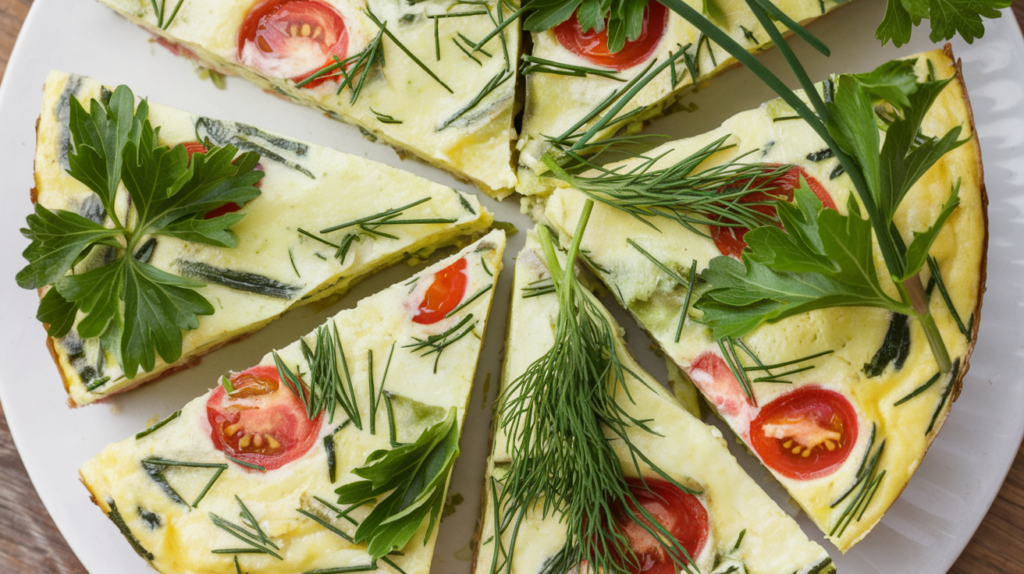
Notes
Herb Variations
Don’t feel constrained by the herbs listed. Basil, mint, oregano, or thyme can all work beautifully in this recipe. The key is using fresh herbs rather than dried – they provide brightness that’s essential to the spring character of this dish.
Make It Dairy-Free
You can easily adapt this recipe for dairy restrictions by omitting the cheese and using a plant-based milk. The herbs provide so much flavor that you won’t miss the dairy. For added richness, try incorporating a tablespoon of nutritional yeast into the egg mixture.
Storage Solution
The frittata will keep well in the refrigerator for up to three days. I actually think it tastes even better on day two! Bring it to room temperature before serving, or gently warm slices in a 300°F oven for about 10 minutes.
Size Adjustments
The recipe can be easily scaled up or down depending on your needs. For a smaller version, use 6 eggs in an 8-inch skillet. For a larger crowd, increase to 14 eggs in a 12-inch skillet and adjust the baking time accordingly.
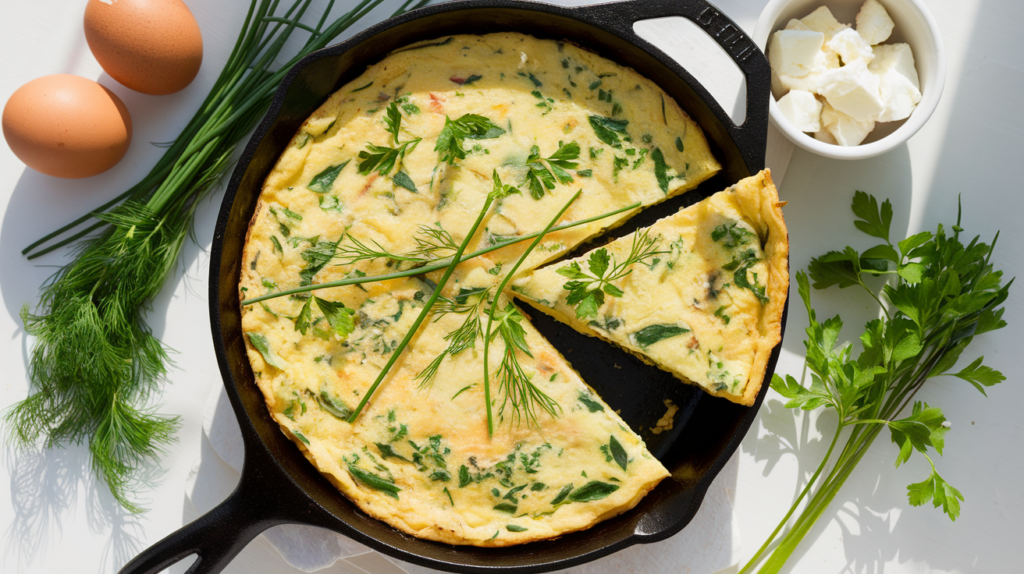
Perfect Pairing
For a complete meal, serve this frittata with a simple arugula salad dressed with lemon vinaigrette. The peppery greens and bright acidity of the dressing perfectly complement the creamy, herb-infused eggs.
Macronutrients Per Serving (Based on 6 servings)
- Calories: 247
- Protein: 17g
- Fat: 18g
- Carbohydrates: 5g
- Fiber: 1g
- Sugar: 2g
- Sodium: 380mg
Pro Tips for Perfect Frittatas
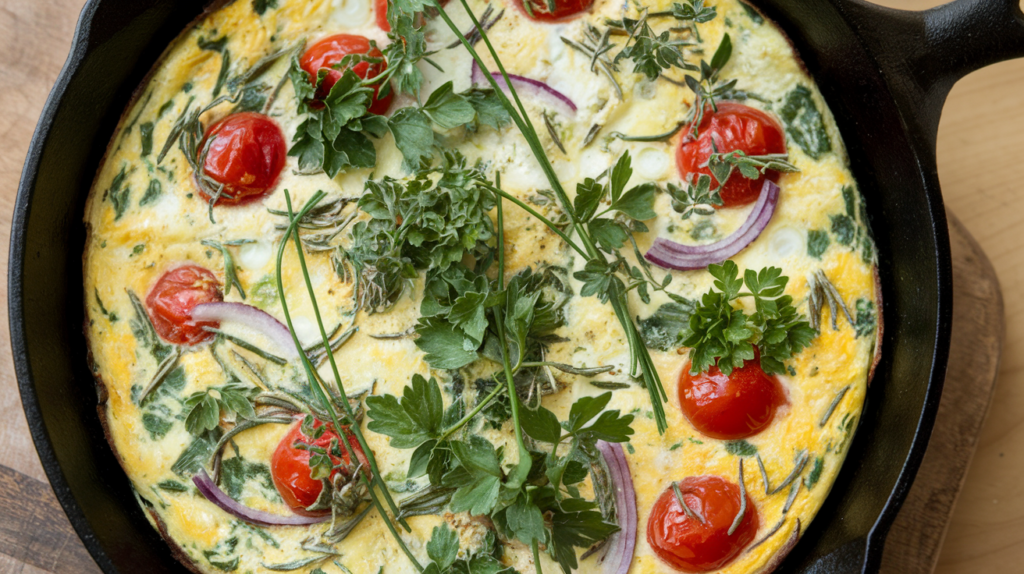
Room Temperature Ingredients
Remove eggs from the refrigerator 30 minutes before cooking. Room temperature eggs create a fluffier texture and more even cooking. Cold eggs straight from the fridge can lead to overcooking at the edges before the center sets properly.
The Blanching Trick
For vegetables with higher water content like zucchini or tomatoes, quickly blanch and thoroughly pat them dry before adding to your frittata. This prevents excess moisture from making your frittata watery – a common pitfall in breakfast frittata recipes.
The Low and Slow Method
Patience is key to a tender frittata. Keep your stovetop heat at medium-low when cooking the egg base. High heat will give you a rubbery texture rather than the silky consistency we’re aiming for.
Perfect Pan Choice
A well-seasoned cast iron skillet is ideal for frittatas as it transitions seamlessly from stovetop to oven and provides even heat distribution. If you don’t have cast iron, any oven-safe skillet will work, but avoid those with plastic handles!
The Wobble Test
To check if your frittata is done, gently shake the pan – you want a slight wobble in the center, similar to a just-set custard. Remember that the frittata will continue cooking from residual heat after it comes out of the oven.
Slicing Strategy
For the cleanest slices, allow your frittata to cool for at least 5 minutes before cutting. Use a sharp knife and wipe it clean between slices for a restaurant-quality presentation.

Frequently Asked Frittata Questions
Can I prepare components ahead of time?
Absolutely! Chop vegetables and herbs the day before and store them in separate containers in the refrigerator. You can even whisk the egg mixture and keep it covered in the fridge overnight. This turns morning assembly into a quick 20-minute affair.
What’s the difference between a frittata and an omelet?
Think of a frittata as the relaxed Italian cousin of the fussy French omelet. Frittatas are cooked slowly, finished in the oven, and usually served in wedges rather than folded. They’re more forgiving and perfect for showcasing multiple ingredients.
How do I prevent my frittata from sticking?
Make sure your pan is well-oiled and heated properly before adding eggs. If using cast iron, ensure it’s well-seasoned. For stubborn sticking issues, try lining the bottom of the pan with parchment paper cut to fit.
Can I freeze leftover frittata?
Yes! Slice the cooled frittata into individual portions, wrap tightly in plastic wrap and then foil, and freeze for up to 2 months. Thaw overnight in the refrigerator and reheat gently in a 300°F oven.
What can I serve with this egg frittata?
A simple green salad, roasted potatoes, or crusty bread make perfect accompaniments. For brunch, pair with fresh fruit and prosecco mimosas. For dinner, a light soup beforehand creates an elegant but easy meal.
How can I tell if my frittata is overcooked?
An overcooked frittata will be dry, shrink away from the sides of the pan significantly, and have a rubbery texture. Look for puffed edges with a slight jiggle in the center when you remove it from the oven.

